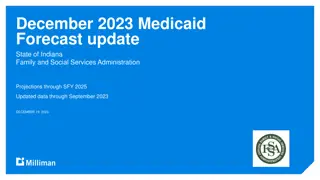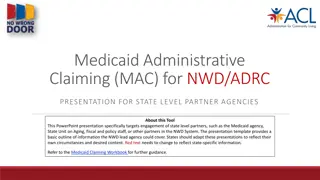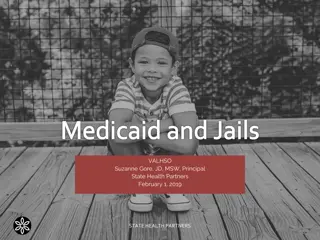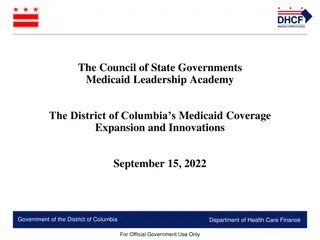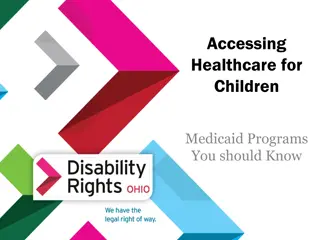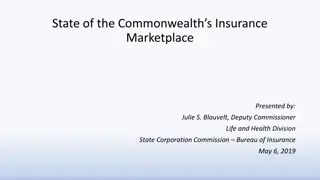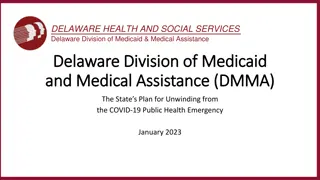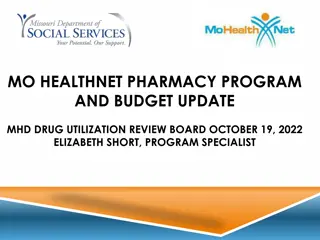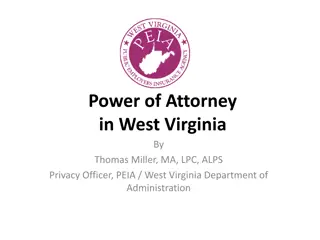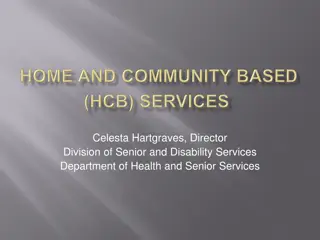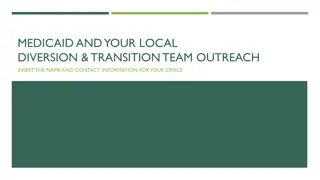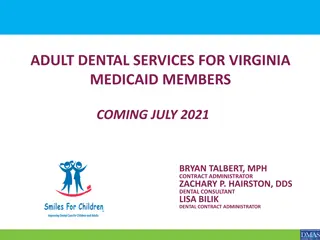Expanding Medicaid: West Virginia's Healthcare Landscape
The Affordable Care Act (ACA) and its impact on Medicaid expansion in West Virginia is examined, focusing on benefits for low-income individuals. The Supreme Court's ruling on the ACA and Medicaid extension options for the state are discussed, emphasizing the need for careful consideration in light of changing healthcare dynamics. Concerns, consumer questions, and implementation steps are highlighted.
Download Presentation

Please find below an Image/Link to download the presentation.
The content on the website is provided AS IS for your information and personal use only. It may not be sold, licensed, or shared on other websites without obtaining consent from the author.If you encounter any issues during the download, it is possible that the publisher has removed the file from their server.
You are allowed to download the files provided on this website for personal or commercial use, subject to the condition that they are used lawfully. All files are the property of their respective owners.
The content on the website is provided AS IS for your information and personal use only. It may not be sold, licensed, or shared on other websites without obtaining consent from the author.
E N D
Presentation Transcript
Expanding Medicaid: West Virginias Best Choice in a Dynamic Healthcare Landscape
Table of Contents I. The Affordable Care Act, the United States Supreme Court, and Options for West Virginia II. The Impact of Expansion: The People & the Cost III. Why Expansion is the Best Choice for West Virginia Under the Current Landscape IV. Addressing Key Concerns Expansion V. Critical Consumer Questions VI. Next Steps: Implementation Timeline Relating to 2
Patient Protection and Affordable Care Act The Patient Protection and Affordable Care Act ( ACA ) was passed in March of 2010 by the United States Congress. The ACA: Creates premium subsidies for low income individuals Enables consumers with pre-existing conditions to access private health insurance through guarantee issue Expands coverage of dependents to age 26 Requires comprehensive benefit threshold in private market Mandates citizens to have health insurance or face tax penalties Mandates large businesses to provide coverage or face tax penalties 3
Patient Protection and Affordable Care Act Prior to Supreme Court Decision, the ACA required states to expand Medicaid to 138% of Federal Poverty Levels (FPL) for individuals aged 19 to 64 or lose ALL Federal Medicaid funding, even for current, established programs. 4
US Supreme Court Rules on Validity of ACA Many States challenged whether the Federal Government could: (1) require individuals to obtain insurance coverage or pay a tax, and (2) force states to expand Medicaid. Supreme Court upheld the ability of Congress to require individuals to obtain coverage or pay a tax. 5
US Supreme Court Rules on Validity of ACA Supreme Court struck down the Federal Government s enforcement mechanism to require Medicaid expansion. West Virginia now has a choice as to whether to extend Medicaid to individuals between the ages of 19 and 64 who make from 17% to 138% of the FPL. Supreme Court left the rest of the ACA intact. 6
Slow Response by US HHS to Supreme Court Ruling July 12, 2012- HHS released letter to Governors following Supreme Court decision leaving many questions unanswered. July 19, 2012- Governor Tomblin submitted letter to US Department of Health and Human Services ( HHS ) Secretary Sebelius relaying West Virginia's concerns about expansion. September 28, 2012- Governor Tomblin submitted second letter to HHS requesting answers related to expansion. 7
Slow Response by US HHS to Supreme Court Ruling December 10, 2012- HHS Letter to Governors and FAQ provides additional, but limited information. January 14, 2013 - HHS releases proposed Medicaid Expansion Rule, still leaving many questions unanswered. May 1, 2013 - HHS has not finalized Medicaid Expansion Rule and indicates piecemeal release of other guidance in coming months. 8
Analyzing Whether to Expand Medicaid in West Virginia Following Supreme Court decision, West Virginia initiated an analysis of Medicaid expansion. West Virginia leveraged a competitively bid actuarial modeling contract (already in place) to analyze the impact on West Virginia of many ACA reforms . 9
Analyzing Whether to Expand Medicaid in West Virginia Initial report was due January 31, 2013, but report was delayed due to lack of information from Federal Government and longer than expected negotiations with private insurance companies to obtain data for the Medicaid expansion modeling. On April 16, 2013, CCRC Actuaries provided a Medicaid Expansion Report ( Report ) to the State detailing anticipated costs. 10
A Topline Summary of the Report on Medicaid Expansion In total, the Report indicates that Medicaid expansion will provide insurance coverage to approximately 91,500 West Virginians, significantly reducing the number of uninsured West Virginians. Combined with other ACA mandates, the number of uninsured West Virginians will drop from 246,000 to 76,000 by 2016 if the State decides to expand Medicaid. 11
A Topline Summary of the Report on Medicaid Expansion The total Medicaid expansion costs for West Virginia will be approximately $375.5 million from FY 2014 through FY 2023, an average of $37.55 million per year over the 10 year period. Expansion results in approximately $5.2 billion in federal dollars coming into the state from FY 2014 through FY 2023, or an average of $520 million per year over the 10 year period. 12
Projected Enrollment Following Expansion (Excluding Elderly/Dual Population)
West Virginia Insurance Coverage Changes Market Changes by 2016 Before ACA Insurance Status After ACA Implementation Insurance Status Current 910,000 28,000 183,000 246,000 1,367,000 ESI 907,000 Non-group Public 18,000 26,000 - 63,000 107,000 Uninsured 71,000 76,000 Employer Sponsored Insurance (ESI) Non-group Medicaid & CHIP Uninsured Total 871,000 1,000 1,000 34,000 17,000 182,000 78,000 277,000 4,000 1,000 - -
Report Estimated Medicaid and CHIP Populations with Expansion Medicaid Expansion -- Summary Population Population (non-elderly/non-dual) (Population in Thousands) FY FY FY FY FY FY FY FY FY FY 2014 2015 2016 2017 2018 2019 2020 2021 2022 2023 Baseline Medicaid Baseline WVCHIP 177.0 172.0 162.0 162.0 162.0 162.0 162.0 162.0 162.0 162.5 23.0 22.0 21.0 21.0 21.0 21.0 21.0 21.0 21.0 21.5 Woodworking Population Change - Medicaid Woodworking Population Change - WVCHIP 0.5 1.0 1.5 2.0 2.0 3.0 2.5 3.0 2.5 3.0 2.5 3.0 2.5 3.0 2.5 3.5 2.5 3.5 2.5 3.5 ACA Mandate Population Change - Medicaid ACA Mandate Population Change - WVCHIP 8.0 -8.0 8.0 -8.0 8.0 -8.0 8.0 -8.0 8.0 -8.0 8.0 -8.0 8.0 -8.0 8.0 -8.0 8.0 -8.0 8.0 -8.0 Expansion Population Change - Medicaid 63.0 78.5 88.5 90.0 91.5 90.5 93.0 94.5 94.5 95.0 Total Population Change - Medicaid Total Population Change - WVCHIP 71.5 -7.0 88.0 -6.0 98.5 100.5 102.0 101.0 103.5 105.0 105.0 105.5 -5.0 -5.0 -5.0 -5.0 -5.0 -4.5 -4.5 -4.5 Total Population - Medicaid Total Population - WVCHIP 248.5 260.0 260.5 262.5 264.0 263.0 265.5 267.0 267.0 268.0 16.0 16.0 16.0 16.0 16.0 16.0 16.0 16.5 16.5 17.0
Report Estimated Costs of Medicaid Expansion Medicaid Expansion (Values in Millions) Affordable Care Act Changes FY 2014 FY 2015 FY 2016 FY 2017 FY 2018 FY 2019 FY 2020 FY 2021 FY 2022 FY 2023 Totals Medicaid Total (State & Federal) Baseline 631.0 71.3% 450.0 $ 181.0 $ 620.5 71.0% 440.5 $ 180.0 $ 591.5 70.5% 417.0 $ 174.5 $ 598.0 70.0% 418.0 $ 179.5 $ 604.5 69.5% 420.0 $ 184.5 $ 612.5 69.0% 422.5 $ 190.0 $ 620.5 68.5% 425.0 195.5 627.5 68.0% 426.5 201.0 636.5 67.5% 429.5 207.0 645.0 67.0% 432.0 213.0 6187.5 69.2% 4,281.5 $ 1,906.0 $ FMAP Federal Funds State Funds $ $ $ $ $ $ $ $ Woodworking & ACA Mandate Costs FMAP Federal Funds State Funds 86.2% 28.0 $ $ 87.0% 33.5 $ $ 87.9% 29.0 $ $ 88.2% 22.5 $ $ 88.5% 23.0 $ $ 88.9% 24.0 $ $ 89.3% 25.0 3.0 87.9% 25.5 3.5 88.3% 26.5 3.5 87.9% 29.0 4.0 87.9% 266.0 36.5 $ $ $ $ $ $ $ $ $ $ 4.5 5.0 4.0 3.0 3.0 3.0 Expansion Costs of Care FMAP Federal Funds State Funds 100.0% 100.0% 100.0% 336.0 $ 429.0 $ - $ - $ 97.5% 512.0 $ 13.0 $ 94.5% 519.0 $ 30.0 $ 93.5% 523.0 $ 36.5 $ 91.5% 542.5 50.5 90.0% 556.5 62.0 90.0% 574.0 64.0 90.0% 595.0 66.0 96.0% 5,090.0 $ 322.0 $ 502.0 $ $ $ $ $ $ $ $ $ $ - Expansion Administrative Costs FMAP Federal Funds State Funds 61.9% 6.5 $ $ 66.7% 11.0 $ $ 65.6% 10.5 $ $ 65.6% 10.5 $ $ 65.6% 10.5 $ $ 65.6% 10.5 $ $ 65.6% 10.5 5.5 66.7% 11.0 5.5 66.7% 11.0 5.5 66.7% 11.0 5.5 65.8% 103.0 53.5 $ $ $ $ $ $ $ $ $ $ 4.0 5.5 5.5 5.5 5.5 5.5 Total Spending with Medicaid Expansion FMAP Federal Funds State Funds 81.2% 820.5 $ 189.5 $ 82.8% 914.5 $ 190.5 $ 83.9% 958.5 $ 184.0 $ 82.7% 963.5 $ 201.0 $ 81.4% 973.0 $ 223.0 $ 80.7% 980.0 $ 235.0 $ 79.8% 1,003.0 $ 254.5 $ 78.9% 1,019.5 $ 272.0 $ 78.8% 1,041.0 $ 280.0 $ 78.7% 1,067.0 $ 288.5 $ 80.8% 9,740.5 $ 2,318.0 $
The Costs of Not Expanding Are Great If West Virginia Does Not Expand, then: Individuals between 17% of FPL and 100% of FPL will be stranded there will be no coverage under Medicaid and no eligibility for premium subsidies in federal exchange. Our federal taxes will go to other States who accept Medicaid expansion. In other words, our taxpayers will not see any tax relief and will be subsidizing Medicaid in other States. 17
The Costs of Not Expanding Are Great (Continued) If West Virginia Does Not Expand, then: The State and our employers will face greater costs related to treating uninsured in hospitals, public clinics, and other care facilities this problem occurs because the Federal Government is reducing other forms of grants and program for health care due to the program being implemented under the ACA. 18
The Costs of Not Expanding Are Great (Continued) If West Virginia Does Not Expand, then: More employers will be assessed penalties under the ACA, ranging from $6 million to $18 million per year. Studies show that premiums paid by West Virginia residents in private market will be 5% higher if Medicaid is not expanded. 19
The Costs of Not Expanding Are Great (Continued) If West Virginia Does Not Expand, then: Our Hospitals, who will lose DSH payments under Medicaid and Medicare under the ACA, will see less revenues and face stark choices in providing key care for our communities without the revenues associated with Medicaid expansion. 20
The Benefits of Expansion By Choosing to Expand Medicaid: The State will be helping working West Virginians i.e., those with income levels from 17% to 138% of FPL obtain insurance. Creates financial security for working families that experience medical hardships. The State will end the disincentive to current Medicaid enrollees from working under expansion impoverished families can work to the middle class and no longer fear losing insurance coverage. 21
The Benefits of Expansion (Continued) By Choosing to Expand Medicaid: Cost of care will be covered by 100% federal funds for first three years, capturing majority of pent-up demand, with $1.267 billion federal dollars at a cost of only $15 million in state administrative match dollars. When match rate fully applied in 2020, Feds will pay $9 for every $10 spent on the expanded population for cost of care. 22
The Benefits of Expansion (Continued) By Choosing to Expand Medicaid: The State can reduce funding to several programs aimed at providing services to uninsured moving from 100% state funding to a 90% federal match. Expansion results in $5.2 billion in federal funds entering the state economy from FY 2014 through FY 2023. 23
The Benefits of Expansion (Continued) By Choosing to Expand Medicaid: Studies show that improved health care translates into a more productive and effective workforce, decreased rates of delayed care and decreased mortality. The State s health sector will see increased economic activity due to the large amount of federal funding coming into the State. 24
The Benefits of Expansion (Continued) By Choosing to Expand Medicaid: Individuals with private insurance will see reductions in the amount of subsidies they provide associated with the delivery of uncompensated care. A large number of individuals will qualify for Medicaid that have substance abuse and behavioral health needs; thus the State will draw down significant federal funds to treat these problems that are now addressed with State funds. 25
Addressing Concerns with Expansion: Fiscal Responsibility Concern: Total Medicaid Expansion expected to cost the State a total of $375.5 million from FY 2014 through FY 2023 In first three years, State s share will be approximately $5 million per year, an easily manageable number. By FY 2020, the State share increases to approximately $65 million. The State must find secure, long term funding streams for that State portion of expansion costs. 26
Addressing Concerns with Expansion: Fiscal Responsibility There are several areas to potentially offset this State responsibility by shifting monies to Medicaid from the following areas whose funding needs will decrease as a result of the ACA. 27
Addressing Concerns with Expansion: Fiscal Responsibility The State currently spends approximately $12 to $15 million per year in uncompensated care. As more individuals have insurance coverage, this requirement will decrease. The State currently spends approximately $20 million for a State match for Medicaid DSH payments. As Federal DSH dollars are reduced, the State s required match will also decrease. The federal match rate for the CHIP program will increase, decreasing the need for State match funds. The Report shows that some PEIA families will go to Medicaid and CHIP; thereby reducing PEIA required funding. 28
Addressing Concerns with Expansion: Fiscal Responsibility (Continued) There are several areas where revenues should increase or cost savings may be used for the State s expanded population Medicaid match. 29
Addressing Concerns with Expansion: Fiscal Responsibility (Continued) The State s provider taxes are based on gross receipts. As providers see increased gross receipts, the State s gross revenues from provider taxes should increase, providing additional dollars for the State s expanded population Medicaid match. The expanded use of managed care, particularly related to substance abuse and behavioral health, can aid in reducing the State s substance abuse problem and creating other cost savings, freeing up resources that may be repurposed for the State s expanded population Medicaid match. The Public Works DHHR Report identified over $50 million in annual savings through efficiencies that can be repurposed for the State s expanded population Medicaid match. 30
Addressing Concerns with Expansion: Federal Stability Concern: The State remains concerned about federal spending and revenue policies, leading to questions as to whether Federal match rates will remain in place. If the Federal government changes the rules of the game, the State must be in a position to re-evaluate ability to manage and pay for expanded population. Given the current dynamics at the Federal level, it does not appear that match rate for first three years will changes a 100% match rate. If the Federal government does not maintain its part of the bargain, West Virginia must protect itself and may be forced to discontinue providing healthcare benefits to the expansion population. 31
Addressing Concerns with Expansion: Federal Stability In addition to fiscal policy, HHS has been slow in finalizing rules and making programmatic decisions. These delays add systemic risk to the ACA. West Virginia and other States must have cooperation and flexibility to respond to HHS as it makes policy choices. WV demands flexibility from HHS to control as much as possible the fiscal impact of expansion on West Virginia. West Virginia must remain vigilant in monitoring federal developments. 32
Addressing Concerns with Expansion: Sovereignty Concern: The State of West Virginia should be given maximum flexibility to address Medicaid costs and delivery. State will explore Innovation Waivers in 2017, adding long term flexibility for the State. West Virginia will engage in ongoing negotiations with HHS and monitor negotiations between states and federal government to allow West Virginia to control its own destiny in every reasonable manner. 33
Addressing Concerns of Expansion: The Problems with the Current Medicaid Program Concern: The Current Medicaid Program has identified weaknesses and funding problems. The State must be dedicated in addressing implementation challenges related to the significant infrastructure and personnel needs associated with expansion. The State must continue to look at ways to address the current Medicaid program faces long term funding issues, which is exacerbated by expansion. 34
Addressing Concerns of Expansion: The Problems with the Current Medicaid Program Medicaid nationally suffers from inefficiency with risk that expansion exacerbates problem, the State must use the Public Works DHHR Report to effectively manage Medicaid. The Public Works Report on DHHR can lead to increased efficiencies at Medicaid in a number of key areas. 35
Addressing the Concerns of Expansion: Controlling Costs Through Managed Care For West Virginia s baseline Medicaid program, services except for behavioral health, personal care, pediatric dentistry, and Non- Emergency Medical Transportation already in the State s managed care system, with millions in savings to the State and Federal Government each year. To effectively control costs, West Virginia will move remaining pieces of services into managed care for CURRENT and EXPANDED population. 36
Addressing the Concerns of Expansion: Controlling Costs Through Managed Care Providing full benefits through managed care model for enrollees: Is proven to control cost Results in better coordination of services to improve outcomes Drives quality through accreditation and contractual monitoring Insulates state from being overexposed with financial risk of years with poor claims Predictable budget for the State The State will also begin a more rigorous process of making sure that managed care organizations provide good outcomes for West Virginia Medicaid recipients. 37
Addressing Concerns with Medicaid Expansion: Personal Responsibility West Virginia will adopt strategies promoting personal responsibility . West Virginia will continue to explore premium assistance and other innovative strategies to reduce cost and improve quality. West Virginia will continue negotiations with Federal government to ensure state goals are reached, state consumer interests protected, and the state s fiscal discipline maintained. 38
Addressing Concerns with Medicaid Expansion: Personal Responsibility Co-pays will be developed by the State that will: Create sliding cost sharing scale, adjusted by consumer income Alleviate some cost burden from state revenue Curb inappropriate utilization, controlling cost Encourage personal responsibility Create larger degree of parity with private market 39
Monitoring Concerns with Medicaid Expansion: Market Instability Although better situated than most states, West Virginia must work with its institutions of higher learning to address any shortages in health care providers given pent-up demand that will be released with expansion and exchanges. Eligibility rules and consumer coverage changes during upcoming months and years will create an administrative burden and public confusion. State must be prepared to answer consumer questions and facilitate timely enrollment issues relating to exchanges and Medicaid expansion. 40
Consumer Question and Answer Q1: When will Medicaid expansion start? A1: Consumers will be able to have their eligibility determined for Medicaid and premium tax credits starting October 1, 2013. Coverage begins January 1, 2014. Q2: How will consumers know if they are eligible for Medicaid expansion? A2: West Virginia consumers will be able to access the Marketplace, an online portal that provides eligibility determination for Medicaid, CHIP, and premium tax credits. Consumers can also call the Federal Exchange call center, which will have ability to determine eligibility. Finally, consumers can go to a local DHHR office, access the support of in-person assisters, navigators, or certified application counselors at designated locations around West Virginia for help determining health coverage eligibility. 41
Consumer Question and Answer Q3: Will businesses be penalized if their employees obtain Medicaid? A3: No. Federal employer penalties for failing to offer minimum essential coverage do not apply to employees that enroll in Medicaid. 42
Medicaid Expansion Timeline The State Bureau for Medical Services will begin preparing a State Plan Amendment to provide for the following: Expanding the Medicaid population Expanding the use of managed care Developing co-pays for Medicaid The plan will be submitted by June 2013, with open enrollment beginning October 1, 2013 43




